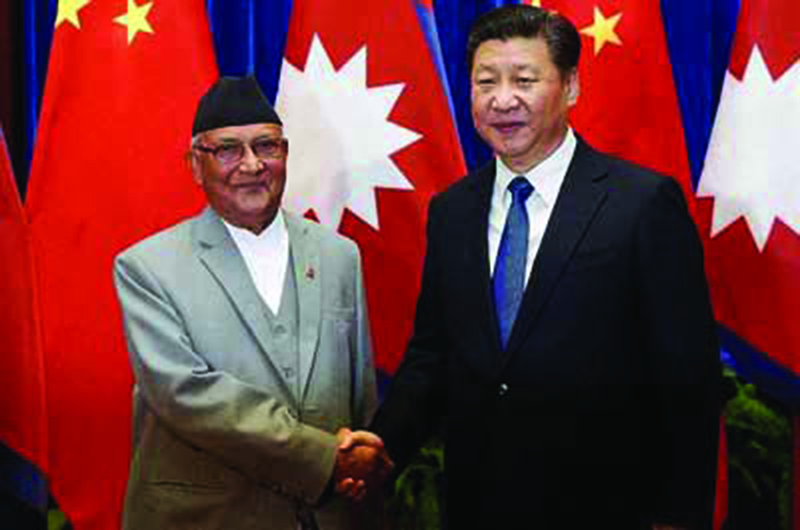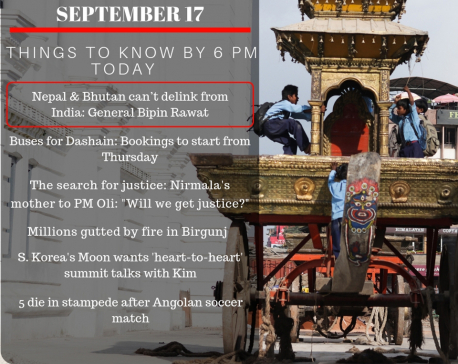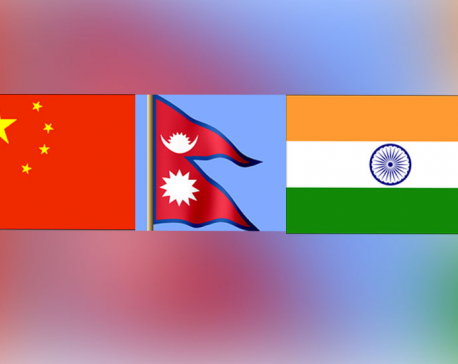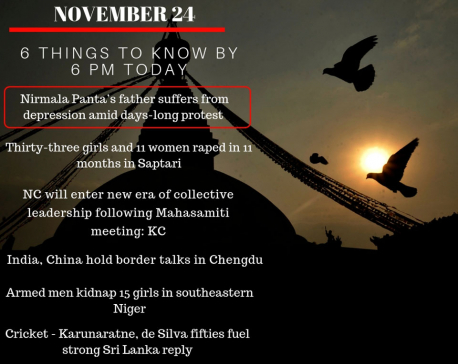
OR

While a joint China-Nepal military exercise scheduled for September 15 will only involve a platoon of soldiers from each side, the maneuvers will be warily watched in neighboring India as yet another sign of Beijing’s march to break its long-time strategic hold on the country.
China and Nepal conducted their first such exercise, known as Sagarmatha Friendship 2017, last April at the Nepalese para-training school in Maharajgunj near the national capital Kathmandu. Those 10-day drills focused on combating terrorism and disaster management.
This year’s drill will take place reciprocally at Chengdu in China’s southwestern Sichuan province as “Sagarmatha Friendship 2.” Sagarmatha is the Nepali name for Mount Everest, the world’s highest mountain which straddles the rugged Sino-Nepalese border.
The military exercise comes at a time when Nepal’s communist-led government is expanding relations with China on multiple fronts.
In May last year, Nepal signed a memorandum of understanding with China to cooperate with its US$1 trillion Belt and Road Initiative (BRI). In June this year, China and Nepal agreed to build a railroad connecting Xigaze in China-controlled Tibet with Kathmandu.
If built, the line would connect Nepal with China’s wider network of railroads and potentially provide the landlocked nation with alternate sources and routes for fuel and other imports that would mitigate its dependence on India. Past plans to import fuel from China did not come to fruition.
The MoU for the railway was signed by Nepal’s Prime Minister Khadga Prasad Sharma Oli during a five-day visit to Beijing, where he met both Chinese president Xi Jinping and premier Li Keqiang.
It was Oli’s second initiative to improve bilateral ties and physical connections with China after he signed a transit trade treaty with Beijing during his previous short-lived tenure as prime minister in 2016.
While Nepal openly wants to reduce its dependence on India for key imports, including fuel, it must strike a careful balance between China and India as the two great powers ramp up rivalry for influence and power across South Asia and beyond.
Nepal’s relations with India are still defined in part from their British colonial days. Independent India and Nepal signed a friendship treaty in 1950, which has long been the cornerstone of Kathmandu’s foreign policy. The treaty established a close strategic relationship that among other things allows Nepal to import arms and ammunition via India.
India remains Nepal’s main foreign trading partner, with more than half of all its official imports and exports crossing the country’s southern border. If prevalent smuggling and other illegal trade is accounted for, Nepal’s dependence on India for its economic livelihood is even higher.
Between one and two million people from Nepal work in India, often mixing with India’s own Nepali communities in northern West Bengal, Sikkim and elsewhere. Their remittances are an important source of income for many impoverished villages in the Himalayan republic.

Military-to-military relations between the two countries are also still strong. Seven Gorkha regiments comprised of soldiers from Nepal serve with the Indian Army. Over the decades India has supplied the Nepalese army with a wide range of weapons; many senior Nepalese officers attended military academies in India.
Joint military exercises between India and Nepal are held regularly, involving far more soldiers from each country than China’s Sagarmatha Friendship drills. The most recent Nepal-India joint exercise took place in June in Uttarakhand on the theme of combating insurgencies and terrorism.
But Nepal’s nascent military cooperation with China will bring the countries closer strategically as Nepal aims to distance itself from India. Relations with New Delhi began to deteriorate as early as the 1970s, when Nepal, then a kingdom, pressed for substantial changes in its friendship treaty with India.
Nepal strongly criticized what it called India’s “annexation” of the kingdom of Sikkim in 1975. New Delhi, in contrast, regarded Sikkim as a dependent state which like other princely states needed to be integrated into India.
By then, a highway had already been built linking Kathmandu with Lhasa in Tibet, creating the first proper road connection between China and Nepal and the beginnings of a strategic hedge to its relations with India.
India-Nepal relations hit a nadir in August 1988, when Nepal purchased anti-aircraft guns from China that New Delhi perceived as a threat. India, also peeved at the time with trade-related issues, retaliated in March 1989 by closing the two sides’ mutual border.

Nepalese police watch protesters throwing rocks near the Nepal-India border during a blockage at Birgunj, some 90km south of Kathmandu, on November 4, 2015. Photo: AFP/Prakash Mathema
The blockade lasted until April 1990 and caused immense hardship for Nepal. Another border blockade imposed in 2015, officially initiated by people of Indian origin in southern Nepal, caused similar problems and led to a rise of anti-Indian sentiment among the Nepalese public.
New Delhi has denied it was behind the 2015 blockade, but many in Kathmandu believe it tacitly supported the move.
China, meanwhile, has pursued a more subtle, often behind-the-scenes, policy towards Nepal. On the cloak-and-dagger front, a major Chinese concern is the presence in Nepal of 20,000 Tibetan refugees, some of whom fled after a 1959 uprising in Lhasa against China’s occupation of Tibet.
According to local Nepal sources, Chinese intelligence operatives regularly meet local Nepali contacts to coordinate spying activities against the exiled Tibetan community in Nepal.
At the official level, China has provided assistance to Nepal for establishing the National Armed Police Force Academy and built a well-equipped China Information Center in Tatopani and Sindhupalchok to monitor for and ferret out anti-Chinese activities along the highway to Tibet.
Towards that aim, China has recently provided Nepali police with a sophisticated Digital Radio Trunking System to enhance their communication capabilities through frequency sharing.

Nepali police guard the Boudhanath Stupa to prevent mass gatherings of Tibetans-in-exile to mark the Dalai Lama’s birthday in Kathmandu on July 6, 2017. Photo: AFP/Prakash Mathema
Since 2002, China has also sent military officers to participate in so-called “adventure training” in Nepal. Beginning in 2008, the Nepalese army has regularly sent officers and soldiers for training at educational institutions in China. The joint military exercises in 2017 served as a sort of capstone of these gradually enhanced exchanges.
As early as 1999, a China Studies Center was set up in Kathmandu with assistance from the Chinese embassy to promote Chinese language and culture free of charge.
China has also worked actively through local nongovernmental organizations (NGOs) and other entities such as the Nepal-China Media Forum, the Nepal-China Mutual Cooperation Society (NCMCS) and the Nepal-China Friendship Society.
The NCMCS, in turn, has provided assistance to the Himani Trust, which takes part in various social welfare activities. China has even encroached upon what has traditionally been India’s turf by providing assistance to the G P Koirala Foundation’s earthquake relief program.
Girija Prasad Koirala, who died in 2008, was a mainly pro-Indian Nepali politician who served as prime minister on four occasions between 1991 and 2008. He was also acting head of state from January 2007 to July 2008 as Nepal transitioned from being a monarchy to a republic.
His departure, some say, opened the way for China to play a more active role in local politics. That’s been seen in China’s active attempts to forge unity among Nepal’s many communist parties. That was achieved nominally in May when Oli’s Communist Party of Nepal (Unified Marxist-Leninists) merged with the Communist Party of Nepal (Maoist Center) to become the Nepal Communist Party (NCP).

Chinese President Xi Jinping (second-right) meets with then Nepalese Prime Minister Pushpa Kamal Dahal (third-left) at the Great Hall of the People on March 27, 2017. Photo: Lintao Zhang/Pool/Reuters
Apart from being prime minister, Oli serves concurrently as co-chairman of the NCP. The other chairman, Pushpa Kamal Dahal, also known as Prachanda, or the “fierce one”, led a violent Maoist insurgency that lasted from 1996 until a peace agreement was reached in 2006. Dahal served as prime minister from 2008 to 2009 and again from 2016 to 2017.
A unified communist bloc would ease Beijing’s dealings with Nepal’s government and provide the stability that China apparently wants in a nation that for years has been ravaged by political instability and long periods of civil war.
Nepal, stuck between the world’s two most populous nations, has often been described as “a jam between two boulders.” The Nepalese are doing what they can to strengthen their economic and now military ties with China to fulfill the country’s longstanding policy of becoming less dependent on India.
But if China’s envisioned network of strategic highways and railroads crosses the Himalayas, India is likely to counter by getting more involved than it already is in Nepal’s domestic politics. Indian intelligence operatives have long been known to be active in making contacts with local politicians and activists in Kathmandu.
New Delhi could also move to impose more blockades and other trade-related punitive measures if its feels China’s influence is drawing too close to its borders. Either way, Nepal risks becoming a new frontline in the rising regional rivalry between China and India for influence and power in South Asia.
You May Like This

Sept 17: 6 things to know by 6 PM today
Your daily dose of missed important news of the day. ... Read More...

Balancing Act: Nepal's Delicate Dance with China and India
Nepal is strategically located between the emerging Asian giants: China and India. It has maintained cordial people-to-people relations with both... Read More...

Nov 24: 6 things to know by 6 PM today
Your daily dose of missed important news of the day. ... Read More...







Just In
- 19 hydropower projects to be showcased at investment summit
- Global oil and gold prices surge as Israel retaliates against Iran
- Sajha Yatayat cancels CEO appointment process for lack of candidates
- Govt padlocks Nepal Scouts’ property illegally occupied by NC lawmaker Deepak Khadka
- FWEAN meets with President Paudel to solicit support for women entrepreneurship
- Koshi provincial assembly passes resolution motion calling for special session by majority votes
- Court extends detention of Dipesh Pun after his failure to submit bail amount
- G Motors unveils Skywell Premium Luxury EV SUV with 620 km range










Leave A Comment